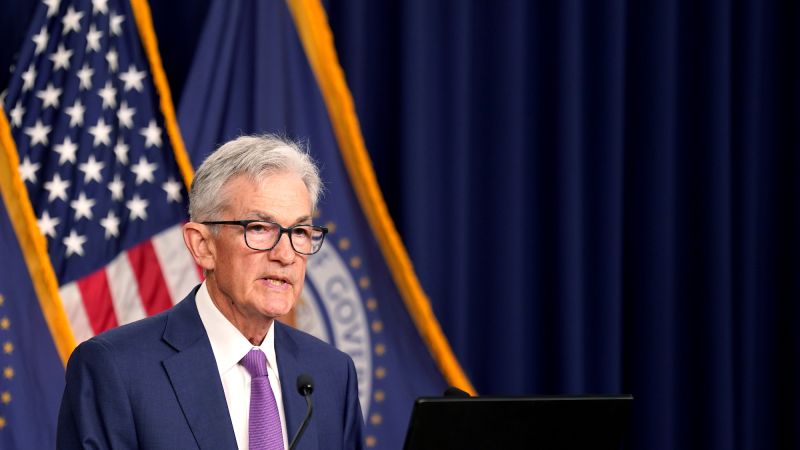The Federal Reserve said Wednesday it is holding interest rates at their current levels, as hotter-than-expected inflation data continues to push back the timing of the first rate cut.
Fed officials have kept their benchmark lending rate at a 23-year high since July, after aggressively raising rates starting two years ago.
Officials have said they need to have enough confidence that inflation is under control before lowering borrowing costs, but the latest figures show “there has been a lack of further progress,” according to their latest policy statement.
US stocks closed mixed Wednesday after Fed Chair Jerome Powell indicated twice during a news conference that policymakers believe interest rates are “restrictive” enough and that it was “unlikely” that the central bank would raise rates again in this cycle. The blue-chip Dow ended Wednesday higher by 87 points, or 0.2%. The S&P 500 fell by 0.3% and the Nasdaq was also down 0.3%.
The Fed also announced Wednesday it is easing its grip on the economy by shrinking its massive multitrillion-dollar balance sheet at a slower pace. The central bank’s main tool is its key interest rate, but it also uses its balance sheet to either help stimulate or slow the economy, and it’s been doing the latter to fight inflation. Starting in June, the Fed will let up to $25 billion in Treasuries from its portfolio mature each month without replacing them, down from $60 billion a month currently.
Here are key takeaways from Powell’s latest comments and what to expect from the Fed in the coming months.
Chair Powell first acknowledged that inflation’s slowdown has stalled during a discussion last month. He continued to express that sentiment Wednesday.
“So far this year, the data have not given us that greater confidence. In particular, as I noted earlier, readings on inflation have come in above expectations,” Powell said, adding that it might “take longer than previously expected” for Fed officials to feel confident enough to cut rates.
The string of disappointing inflation figures not only dealt some serious damage to the chances of a rate cut in the summer, but it also sparked chatter about the possibility of another rate hike.
But Powell said that “it’s unlikely that the next policy rate move will be a hike,” noting that officials would need to see “persuasive evidence that our policy stance is not sufficiently restrictive to bring inflation sustainably down to 2%.”
It is very unclear when the Fed will finally begin to reduce interest rates, but Powell said there are multiple scenarios that could kick off rate cuts, including a scenario in which inflation resumes its slowdown as both the economy and job market remain strong — the “Goldilocks” type of situation that took place last year.
He said a persistently strong economy, coupled with inflation continuing to stall, would simply result in the Fed holding off on cutting rates, but added that an “unexpected weakening in the labor market” could speed up the first cut.
The job market overall remains robust, with unemployment still under 4% and employers continuing to hire workers at a brisk pace. The Labor Department releases April figures on hiring, wage gains and unemployment on Friday.
When asked if he still agrees with Fed officials’ median projection of three rate cuts in 2024, Powell did not provide a direct answer.
Economists are still widely expecting both inflation and the broader US economy to cool further in the second half of the year. Powell thinks so too.
Interest rates are high, pandemic savings are dwindling, Americans are racking up credit card debt and still-high inflation continues to take a bite out of people’s budgets. All of that is expected to tug on the economy’s reins in the coming months.
The Fed’s aggressive rate-hiking campaign has already had some effects on certain pockets of the economy, such as housing and business deal-making. Mortgage rates soared as the Fed hiked rates, leading to home sales plummeting to their lowest level in decades last fall. Mergers and acquisitions slowed sharply in the second half of 2022 as the Fed lifted rates.
Powell also pointed to the labor market’s gradual slowdown from 2022 when job openings exceeded the number of unemployed people seeking work by the widest margin in history.
Still, the broader economy hasn’t felt the full effects of high interest rates just yet. The economy expanded robustly in 2023, thanks to strong household spending, despite the Fed jacking up to rates to their current levels. The solid job market was key in powering spending last year and there currently aren’t any signs of a sharp pullback on the horizon.
But inflation is stuck and, coupled with the economy’s resilience, the Fed is expected to push back the timing of the first rate cut, according to futures and forecasts from analysts at major banks. JPMorgan and Goldman Sachs are projecting the first cut to come in July, while Wells Fargo is betting on September and Bank of America estimates the first cut in December.
Wall Street’s best bet for the first rate cut is currently November, according to the CME FedWatch Tool. Economists say the bar for another rate hike is very high and most forecasters currently aren’t estimating that.
Powell is waiting on private data showing declining rents eventually trickled through to government inflation gauges. The Fed chief also hinted that the economy is not in stagflation.
“I don’t really understand where that’s coming from,” he said.
Read the full article here
















